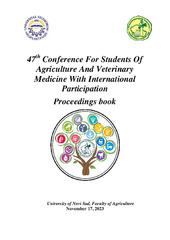| dc.description.abstract | Among decorative petals of some plant species, lies a hidden wide array of bioactive
components, representing a potential source of health-promoting compounds. Predominantly
known as a group of vegetables with great economic importance, the Brassicaceae family
stands out with an abundant number of species whose flowers are edible. One such species is
Diplotaxis tenuifolia (L.) DC., a versatile plant, commonly grown for its deeply lobed leaves
which are widely used in gastronomy. However, there is limited available data regarding the
phytochemical profile of its edible flowers. The aim of this study was to compare two different
extraction solvents (80% acetone and 80% methanol) with regard to the phytochemical yield
and antioxidant activity of D. tenuifolia flowers. Furthermore, using spectrophotometric
methods, the analyses of total phenolic content (TPC), total flavonoid content (TFC), and
total hydroxycinnamic acid derivatives content (HCAs) were performed, in addition to
determining the total content of pigments (chlorophyll a, chlorophyll b, and carotenoids)
from acetone extract. In terms of the total content of pigments, chlorophyll b was the most
abundant (27.83 µg/g of fresh weight (FW)), while chlorophyll a exhibited the lowest
concentration (9.34 µg/g FW). The content of TPC was higher in the acetone extract (8.29
mg GAE /g FW), whereas the yield of TFC was greater in the methanolic extract (2.00 mg
QE /g). As for the total hydroxycinnamic acid derivative content (HCAs) the applied solvents
did not statistically significantly influence the yield. Nevertheless, the antioxidant properties
of both extracts were assessed through four distinct assays: DPPH•
quenching assay, ferric
reducing power (FRP), in vitro phosphomolybdenum total antioxidant capacity (TAC), and
cupric reducing antioxidant capacity (CUPRAC). Phytochemical analyses revealed
differences in the quencher assay results when the two solvents were used. The methanol
extract exhibited higher DPPH•
activity at 10.17 μmol Trolox/g FW, as confirmed by
statistical analysis, which demonstrated significant variations among the solvents used.
Similarly, regarding the TAC results, methanol extract yielded higher values (6.61 mg AAE /g
FW) as opposed to the acetone extract (4.85 mg AAE /g FW), although the statistical analysis
indicated a lack of statistically significant differences among the solvents. Moreover, the
results of FRP and CUPRAC assays were contrasted. In the FRP analysis, acetone extracts
exhibited superior antioxidant activity (5.07 mg AAE/g FW) compared to the methanol
extract (4.24 mg AAE/g), whereas in the CUPRAC assay, methanol extracts displayed a
108
higher level at 29.19 mg AAE/g FW indicating possible differences in extracted bioactive
compounds. The values exhibited statistically significant differences among the solvents used
in each assay. The obtained findings reveal that wild rocket flowers can serve as a valuable
source of bioactive compounds with health-promoting properties, and the choice of solvent
influences their yield, which is significant for possible pharmaceutical and/or food
applications. | sr |


